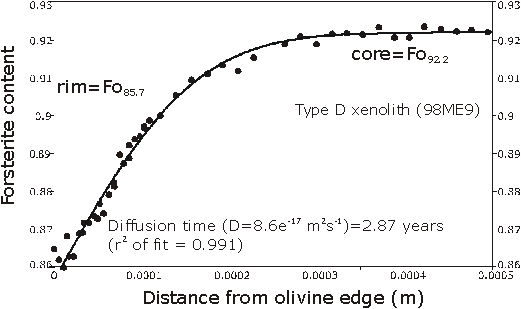

Clinopyroxenites are commonly found as xenoliths at many localities in the Quaternary West Eifel volcanic field. In the western and central part of the field they occur together with peridotites. However in the eastern part of the field, in the area around the Dauner Maar, peridotite xenoliths are absent and clinopyroxenites are the only mafic xenoliths. Clino-pyroxenites from four localities contain fragments of peridotite. These fragments are predominately single crystals of olivine, which show well defined undulatory extinction. However a few polycrystalline fragments have been found that contain relic orthopyroxene and spinel. No primary clinopyroxene has been found in any of the peridotite fragments.
Peridotite olivine grains can be identified on the basis of their deformation lamellae, corroded and overgrown rims and in some cases their high Fo content. In most samples the cores of the grains have Fo contents characteristic of peridotite (i.e., Fo 88 - 92) whereas the rims are much more iron-rich (Fo ~ 70 - 76). These rims indicate that the peridotite olivines underwent Fe-Mg exchange with the iron-enriched melt that formed the clinopyroxenites and in this way they preserve evidence of their residence time in the clinopyroxenite forming magma. Preliminary analysis of the compositional profiles at the edge of the olivine grains (Figure 3.6-2) using a 1-dimensional diffusion model for Fe-Mg interdiffusion between olivine and melt gives contact times ranging from 1 to 5 years.
These data indicate that xenoliths picked up from the mantle by rising magma were partly digested as they were transported with most of the digestion taking place when these magmas stalled either in the uppermost mantle or in the crust. Since olivine is relatively resistant to dissolution it was preserved whereas the more easily dissolved orthopyroxene and clinopyroxene were generally completely removed. This resulted in fragmentation of the peridotites leaving only olivine as evidence of the former presence of peridotite. The short residence times of the peridotite fragments in the clinopyroxenite cumulates indicates that the magmatic system beneath the Eifel was extremely dynamic with cumulates being entrained by later batches of magma a very short time after they had solidified.
 |

Tel: +49-(0) 921 55 3700 / 3766, Fax: +49-(0) 921 55 3769, E-mail: bayerisches.geoinstitut(at)uni-bayreuth.de
 Previous page
Previous page